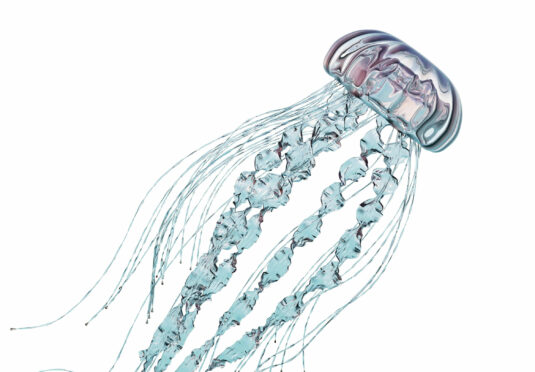
A surge in sightings of jellyfish with stinging tentacles up to 30 metres long in the seas around Scotland have prompted warnings for swimmers.
Huge lion’s mane jellyfish can deliver a nasty sting and are being spotted close to Scotland’s beaches and in sea lochs as their season peaks between now and the end of August.
Sea swimmers have warned of rising numbers of sightings of lion’s manes, which can resemble seaweed, and many report suffering painful stings. They have warned of jellyfish encounters in the Hebrides, the Firth of Forth, Ayr beach, Dunoon and Inverkip. Some sightings have included vast barrel jellyfish, known as a floating dustbin.
Jellyfish are mysterious creatures of the sea that have largely confounded the efforts of scientists to understand them. Major research projects have been carried out to try to establish the factors behind their abundance but none has succeeded in predicting when or where they will be found in large numbers.
Studies suggests jellyfish populations are cyclical and their number and location can fluctuate from year to year, depending on factors such as wind direction, currents and temperatures.
With reports of high numbers by swimmers in Scotland, experts believe they may be in a period of boom – or a concentrated abundance.
The popularity of wild swimming has also soared during the pandemic and, with more people taking holidays near Scotland’s beaches, an increase in people in the water may have led to an increase in incidents and sightings.
Last month 11-year-old Abbie Mcintosh was taken to hospital after being stung on the feet, legs and wrist by a lion’s mane jellyfish in Pettycur Bay in Fife.
The Open Water Swimming Society said: “Jellyfish like warm water as much as swimmers do. In temperate waters our jellyfish tend more towards a negligible or easily treated sting, perhaps occasionally painful, and powerful enough to disrupt a swim.”
Wild swimmers rely on word of mouth and sharing warnings online about the presence of jellyfish. They are also advised to wear wetsuits and avoid swimming alone.
Libby Bligh, a keen swimmer who survived a severe allergic reaction after being stung by a lion’s mane jellyfish at a beach near Nairn in September, said: “Even the consultant who treated me said loads of wild swimmers were saying there are more jellyfish, they’re bigger than they were, they’re here in bigger quantities and for longer periods of time.
“Friends have said usually they’d expect to see one or two lion’s manes in the warmer months but last year we were seeing them from April or May all the way through to October. This year there are loads of them already.”
David Donnan, marine sustainability manager at NatureScot, said: “The lion’s mane jellyfish is probably the one that has the most capacity to sting.
“Jellyfish numbers can fluctuate quite dramatically and can be different from year to year, and even within a year from place to place. There’s a variety of factors that probably influence that.
“There’s some work that points to jellyfish numbers moving in cycles so there are periods of boom and bust.
“There are some places in the world where jellyfish have been becoming more abundant on a sustained basis but that’s probably not the case for us at the moment in Scottish waters.
“There’s no one factor that can explain the variability and abundance but, for example, if we had a sustained period of wind from the west then in particular the sea lochs can see quite high numbers building up.”
Donnan said that for most swimmers a jellyfish sting is no more serious than one from a nettle.

Enjoy the convenience of having The Sunday Post delivered as a digital ePaper straight to your smartphone, tablet or computer.
Subscribe for only £5.49 a month and enjoy all the benefits of the printed paper as a digital replica.
Subscribe